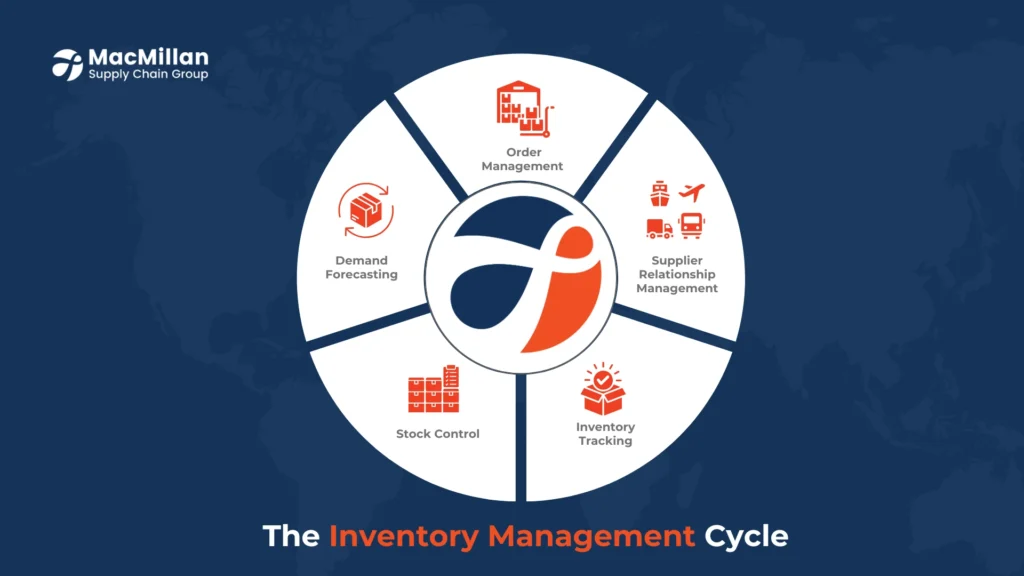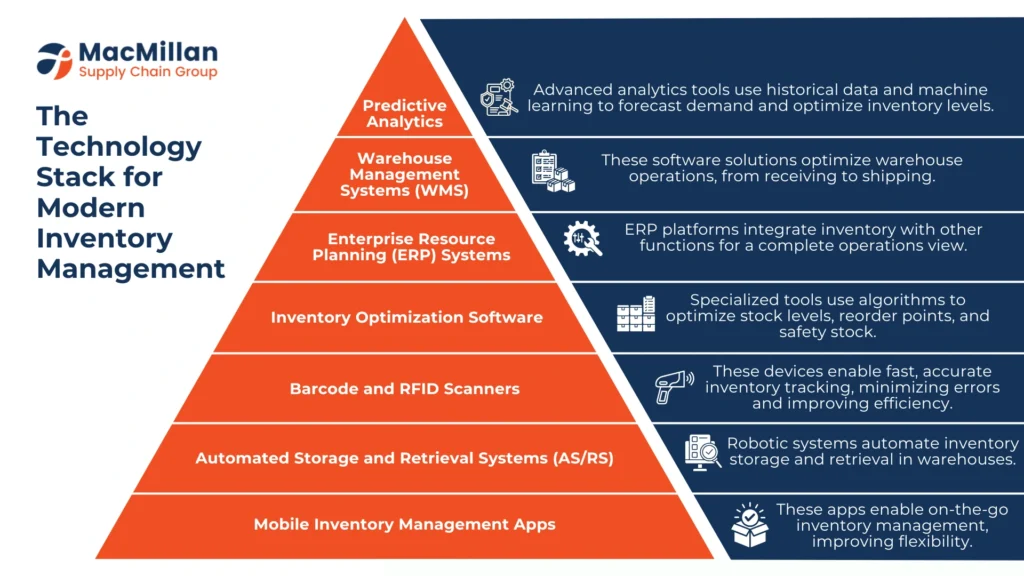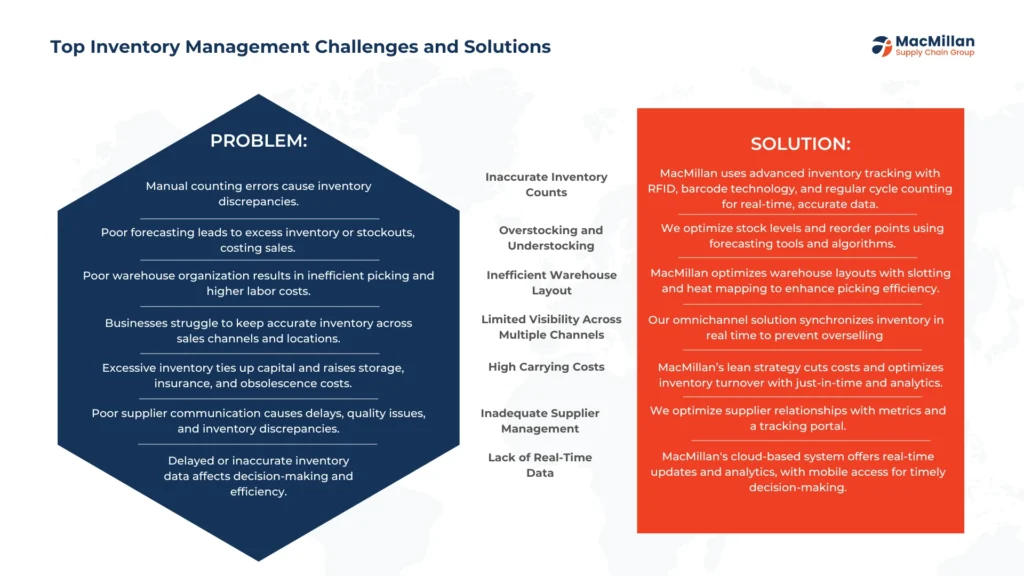A quick summary and overview
Effective inventory management is crucial for business success, impacting everything from customer satisfaction to profitability. This comprehensive guide explores key strategies and best practices for optimizing inventory control, reducing costs, and enhancing overall supply chain efficiency. We’ll delve into the challenges faced by businesses in managing their inventory and how MacMillan Supply Chain Group’s innovative solutions can address these issues. Whether you’re a small business owner or a logistics professional in a large corporation, this article will provide valuable insights to help you master inventory management and drive sustainable growth.
An introduction
In today’s fast-paced business environment, mastering inventory management is more critical than ever. The ability to efficiently track, control, and optimize inventory levels can mean the difference between thriving and struggling in a competitive marketplace. Effective inventory management not only ensures that you have the right products in the right quantities at the right time but also minimizes carrying costs, reduces waste, and improves cash flow.
This article will explore the fundamental principles of inventory management, discuss common challenges, and introduce cutting-edge strategies to enhance your operations. We’ll also highlight how partnering with a trusted logistics expert like MacMillan Supply Chain Group can provide tailored solutions to meet your unique inventory management needs. By the end of this guide, you’ll be equipped with the knowledge and tools to transform your inventory management processes and drive business growth.

The Fundamentals of Inventory Management
Inventory management is the systematic approach to sourcing, storing, and selling inventory—both raw materials and finished goods. At its core, effective inventory management aims to have the right products in the right quantities at the right time. This delicate balance is crucial for meeting customer demand while minimizing excess stock and associated costs.
Key components of inventory management include:
- Demand Forecasting: Predicting future sales to inform purchasing decisions.
- Stock Control: Maintaining optimal inventory levels to meet demand without overstocking.
- Inventory Tracking: Accurately monitoring stock levels, locations, and movements.
- Order Management: Efficiently processing and fulfilling customer orders.
- Supplier Relationship Management: Collaborating with suppliers to ensure timely and accurate deliveries.
Implementing these fundamentals requires a combination of strategic planning, operational execution, and often, technological support. Modern inventory management systems integrate these components, providing real-time visibility and data-driven insights to inform decision-making.
Understanding these basics is crucial, but the real challenge lies in applying them effectively in your specific business context. This is where partnering with experts like MacMillan Supply Chain Group can make a significant difference, offering tailored strategies and advanced tools to optimize your inventory management processes.
Common Inventory Management Challenges
Even with a solid understanding of inventory management principles, businesses often face several challenges in practice. Recognizing these obstacles is the first step toward overcoming them:
- Inaccurate Forecasting: Predicting demand accurately is complex, especially in volatile markets or for seasonal products. Inaccurate forecasts can lead to overstocking or stockouts.
- Inventory Obsolescence: Rapidly changing consumer preferences or technological advancements can render inventory obsolete, resulting in financial losses.
- Poor Visibility: Lack of real-time inventory data across multiple locations or channels can lead to inefficient stock allocation and missed sales opportunities.
- Inefficient Processes: Manual inventory counts and data entry are time-consuming and prone to errors, impacting overall efficiency.
- Cash Flow Management: Tying up too much capital in inventory can strain cash flow, affecting other areas of the business.
- Supply Chain Disruptions: External factors like natural disasters, geopolitical events, or pandemics can disrupt supply chains, affecting inventory levels.
- Multichannel Complexity: Managing inventory across various sales channels (e-commerce, brick-and-mortar, wholesale) presents coordination challenges.
- Warehouse Space Optimization: Inefficient use of storage space can increase carrying costs and complicate inventory management.
Addressing these challenges requires a multifaceted approach, combining strategic planning, technological solutions, and often, expert guidance. MacMillan Supply Chain Group specializes in helping businesses navigate these complexities, offering customized solutions to overcome inventory management hurdles.
Advanced Strategies for Inventory Optimization
To stay competitive in today’s market, businesses must go beyond basic inventory management practices and embrace advanced strategies for optimization. Here are some cutting-edge approaches:
- Just-in-Time (JIT) Inventory: This approach minimizes inventory holding by receiving goods only as they are needed in the production process, reducing carrying costs and improving cash flow.
- ABC Analysis: Categorizing inventory items based on their value and importance allows for more focused management of high-priority stock.
- Vendor-Managed Inventory (VMI): Shifting inventory management responsibilities to suppliers can streamline processes and reduce administrative burden.
- Cross-Docking: This technique involves transferring incoming shipments directly to outgoing vehicles, minimizing storage time and handling costs.
- Demand-Driven Material Requirements Planning (DDMRP): This method combines aspects of Material Requirements Planning (MRP) and Lean principles to improve inventory positioning and flow.
- Artificial Intelligence and Machine Learning: Leveraging AI for demand forecasting and inventory optimization can significantly improve accuracy and efficiency.
- IoT and RFID Technology: Implementing Internet of Things (IoT) devices and Radio-Frequency Identification (RFID) tags enables real-time tracking and automated data collection.
- Continuous Review System: This approach involves constantly monitoring inventory levels and placing orders when stock reaches a predetermined reorder point.
Implementing these strategies effectively often requires specialized expertise and advanced technological solutions. MacMillan Supply Chain Group offers comprehensive support in adopting and integrating these advanced techniques into your inventory management processes.

The Role of Technology in Modern Inventory Management
Technology plays a pivotal role in revolutionizing inventory management practices. Advanced software solutions and hardware innovations are enabling businesses to achieve unprecedented levels of efficiency and accuracy in their inventory processes. Key technological advancements include:
- Warehouse Management Systems (WMS): These comprehensive software solutions optimize warehouse operations, from receiving and put-away to picking, packing, and shipping.
- Enterprise Resource Planning (ERP) Systems: ERP platforms integrate inventory management with other business functions, providing a holistic view of operations.
- Inventory Optimization Software: Specialized tools use advanced algorithms to determine optimal stock levels, reorder points, and safety stock.
- Barcode and RFID Scanners: These devices enable quick and accurate inventory tracking, reducing human error and increasing efficiency.
- Automated Storage and Retrieval Systems (AS/RS): Robotic systems that automate the process of storing and retrieving inventory in warehouses.
- Cloud-Based Inventory Management: Cloud solutions offer real-time visibility and access to inventory data from anywhere, facilitating better decision-making.
- Predictive Analytics: Advanced analytics tools use historical data and machine learning to forecast demand and optimize inventory levels.
- Mobile Inventory Management Apps: These applications allow for inventory management on-the-go, improving flexibility and responsiveness.
Implementing the right technology stack is crucial for modern inventory management success. MacMillan Supply Chain Group specializes in assessing your unique needs and recommending the most suitable technological solutions to enhance your inventory management capabilities.

Common problems with Inventory Management and Our Solutions
Inventory management presents numerous challenges for businesses across industries. Here are some common problems and how MacMillan Supply Chain Group addresses them:
Inaccurate Inventory Counts
Problem: Manual counting processes are prone to errors, leading to discrepancies between recorded and actual inventory levels.
Solution: MacMillan implements advanced inventory tracking systems, including RFID and barcode technology, coupled with regular cycle counting procedures. Our WMS provides real-time visibility, ensuring accurate inventory data at all times.
Overstocking and Understocking
Problem: Poor demand forecasting leads to excess inventory tying up capital or stockouts resulting in lost sales.
Solution: We utilize sophisticated demand forecasting tools that incorporate historical data, market trends, and seasonality. Our inventory optimization algorithms determine ideal stock levels, reorder points, and safety stock for each SKU.
Inefficient Warehouse Layout
Problem: Poorly organized warehouses lead to inefficient picking processes and increased labor costs.
Solution: MacMillan’s warehouse optimization experts conduct thorough analyses to design optimal layout strategies. We implement slotting optimization and use heat mapping to position fast-moving items strategically, improving picking efficiency.
Limited Visibility Across Multiple Channels
Problem: Businesses struggle to maintain accurate inventory levels across various sales channels and locations.
Solution: Our omnichannel inventory management solution provides a centralized view of inventory across all channels. Real-time synchronization ensures consistent stock levels, preventing overselling and improving customer satisfaction.
High Carrying Costs
Problem: Excessive inventory ties up capital and increases storage, insurance, and obsolescence costs.
Solution: MacMillan’s lean inventory management approach minimizes carrying costs while maintaining service levels. We implement just-in-time strategies where appropriate and use advanced analytics to optimize inventory turnover.
Inadequate Supplier Management
Problem: Poor communication with suppliers leads to delays, quality issues, and inventory discrepancies.
Solution: We establish robust supplier relationship management processes, including performance metrics, regular evaluations, and collaborative forecasting. Our supplier portal facilitates seamless communication and order tracking.
Lack of Real-Time Data
Problem: Delayed or inaccurate inventory information hampers decision-making and operational efficiency.
Solution: MacMillan’s cloud-based inventory management system provides real-time updates and analytics. Mobile applications enable on-the-go access to critical inventory data for timely decision-making.
Inefficient Returns Management
Problem: Poorly managed returns processes lead to inventory discrepancies and customer dissatisfaction.
Solution: We implement streamlined returns management workflows, including automated RMA processes, quality inspections, and efficient restocking procedures. Our system ensures returned items are properly accounted for and reintegrated into available inventory.
By addressing these common inventory management problems with tailored solutions, MacMillan Supply Chain Group helps businesses optimize their operations, reduce costs, and improve customer satisfaction. Our comprehensive approach combines cutting-edge technology, industry expertise, and customized strategies to transform your inventory management processes.
How can readers avoid problems or implement solutions
To avoid common inventory management pitfalls and implement effective solutions, consider the following steps:
- Conduct a thorough assessment of your current inventory management processes to identify areas for improvement.
- Invest in robust inventory management software that aligns with your business needs and integrates with your existing systems.
- Implement regular cycle counting procedures to maintain accurate inventory data.
- Develop a comprehensive demand forecasting strategy that incorporates historical data, market trends, and expert insights.
- Optimize your warehouse layout and picking processes to improve efficiency and reduce labor costs.
- Establish strong relationships with suppliers and implement collaborative forecasting practices.
- Regularly review and adjust your inventory policies to ensure they align with changing business needs and market conditions.
- Train your staff on best practices in inventory management and the proper use of inventory management tools.
While these steps can help improve your inventory management processes, partnering with an experienced logistics provider like MacMillan Supply Chain Group can accelerate your progress and ensure long-term success. Our team of experts can provide a comprehensive assessment of your inventory management needs, develop tailored solutions, and guide you through the implementation process.
Don’t let inventory management challenges hold your business back. Contact MacMillan Supply Chain Group today to discover how our innovative solutions and industry expertise can transform your inventory management processes, driving efficiency, reducing costs, and fueling business growth.
FAQs
Effective inventory management is crucial for maintaining optimal stock levels, reducing carrying costs, improving cash flow, and ensuring customer satisfaction. It helps businesses avoid stockouts, minimize excess inventory, and make informed decisions about purchasing and production.
MacMillan offers comprehensive inventory management solutions tailored to your specific needs. We provide advanced technology implementations, process optimization, demand forecasting, and expert consultation to streamline your inventory operations, reduce costs, and improve overall efficiency.
We utilize a range of cutting-edge technologies, including Warehouse Management Systems (WMS), RFID tracking, barcode systems, predictive analytics, and cloud-based inventory management platforms. Our solutions are customized to fit your unique requirements and integrate seamlessly with your existing systems.
To reduce carrying costs, focus on optimizing inventory levels, improving demand forecasting, implementing just-in-time inventory practices, and streamlining warehouse operations. MacMillan can help you develop and implement strategies to minimize carrying costs while maintaining service levels.
Cycle counting is the practice of continuously counting a portion of inventory on a regular basis, rather than conducting a full physical inventory count annually. It's important because it helps maintain inventory accuracy, identifies discrepancies early, and reduces the need for disruptive full inventory counts.
Improving demand forecasting accuracy involves analyzing historical data, considering market trends, incorporating seasonal factors, and leveraging advanced analytics tools. MacMillan's expertise in demand forecasting can help you develop more accurate predictions and optimize your inventory levels accordingly.
A periodic inventory system involves physical counts at specific intervals to update inventory records, while a perpetual inventory system continuously updates records in real-time as transactions occur. MacMillan typically recommends and implements perpetual systems for more accurate and timely inventory management.
Managing inventory across multiple channels requires centralized inventory visibility and real-time synchronization. MacMillan's omnichannel inventory management solutions provide a unified view of inventory across all channels, ensuring consistent stock levels and preventing overselling.
A WMS improves inventory accuracy, optimizes warehouse space utilization, enhances picking and packing efficiency, provides real-time visibility, and facilitates better decision-making. MacMillan can help you select and implement the right WMS for your business needs.
Regular review of inventory management strategies is essential to adapt to changing business needs and market conditions. We recommend quarterly reviews at a minimum, with more frequent adjustments based on business dynamics. MacMillan provides ongoing support and consultation to ensure your inventory management strategies remain optimized.




